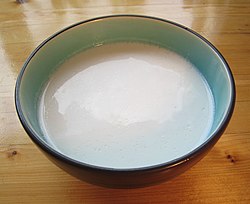Santan
 | |
| Region or state | Traditional: Southeast Asia, Oceania, South Asia, East Africa Introduced: Caribbean, Central America, northern parts of South America, West Africa |
|---|---|
| Main ingredients | Piasau |
Santan nopo nga cecair opurak apakat i naanu maya ekstrak mantad nurudan tonsi piasau.[1][2] Kepekatan om roso kaya do santan nopo nga gama akawas o miak, om kogumuan nopo dii nga lunok tepu. Santan nopo nga pomorolot nansakan tradisional i gunoon id Asia Tenggara, Oceania, Asia Kabaatan, om Afrika Kosilahon. Gunoon nogi ii montok mogonsok id Caribbean, Amerika Tanga, boogian kosilahon Amerika Kabaatan om Afrika Kotonobon id nombo pinountutun ii maso era panaladan (penjajahan).
Milo pibagalon o santan kumaa piipiro kawo tumanud suang (kandungan) lunok dau. Miampai umum, milo ii diklasifikasi kumaa krim piasau (toi ko' santan apakat) miampai lunok bobos akawas; santan (toi ko' santan cair) miampai maksimum kiikiro 20% lunok; om susu piasau skim miampai lunok di osiriba.[3][4] Au insaru gunoon o istilah diti montok santan komersial i pobolion id pogun Barat.[5]
Milo nogi gunoon o santan montok papaasil do ponowoli susu (ointutunan sabaagi "tiinumon santan"). Produk ngaawi nopo diti nga au kaagal miampai produk santan toomod i koubasanan gunoon montok mogonsok, okon ko' inumon.[6] produk santan oomis om noproses mantad Puerto Rico ointutunan sabaagikrim piasau. Insaru ii gunoon montok pencuci mulut om tiinumon miagal do piña colada, sundung do au daa kosudong ii borulongon miampai krim piasau toomod.[5][7]
Nutrisi
[simbanai | simbanai toud]| Nutritional value per 100 g | |||||||||||||||||||||||||||||||||||||||||||||||||
|---|---|---|---|---|---|---|---|---|---|---|---|---|---|---|---|---|---|---|---|---|---|---|---|---|---|---|---|---|---|---|---|---|---|---|---|---|---|---|---|---|---|---|---|---|---|---|---|---|---|
| Energy | 962 kJ (230 kcal) | ||||||||||||||||||||||||||||||||||||||||||||||||
5.5 g | |||||||||||||||||||||||||||||||||||||||||||||||||
| Sugars | 3.3 g | ||||||||||||||||||||||||||||||||||||||||||||||||
| Dietary fibre | 2.2 g | ||||||||||||||||||||||||||||||||||||||||||||||||
23.8 g | |||||||||||||||||||||||||||||||||||||||||||||||||
| Saturated | 21.1 g | ||||||||||||||||||||||||||||||||||||||||||||||||
| Monounsaturated | 1.0 g | ||||||||||||||||||||||||||||||||||||||||||||||||
| Polyunsaturated | 0.26 g | ||||||||||||||||||||||||||||||||||||||||||||||||
2.3 g | |||||||||||||||||||||||||||||||||||||||||||||||||
| |||||||||||||||||||||||||||||||||||||||||||||||||
| Other constituents | Quantity | ||||||||||||||||||||||||||||||||||||||||||||||||
| Water | 67.6 g | ||||||||||||||||||||||||||||||||||||||||||||||||
| †Percentages estimated using US recommendations for adults,[8] except for potassium, which is estimated based on expert recommendation from the National Academies.[9] | |||||||||||||||||||||||||||||||||||||||||||||||||
Id suang hidangan 100 milliliter (ml), kiwaa 230 kilocalories do santan om ii nopo nga mantad 68% waig, 24% ginumu lunok, 6% karbohidrat, om 2% protein (intangai nuludan/jadual). Komposisi lunok nopo nga papahangkum do 21 gram lunok tepu, miampai sampapas nopo mantad dii nga asid laurik.[10]
Santad nopo nga toud togumu (20% toi ko' lobi mantad Daily Value, DV) do mangan (44% DV monikid 100 g) om toud di kabagal (10–19% DV pmonikid 100 g) do fosforus, zat besi, om magnesium, miampai aiso nutrien suai id suang dii i atalang (intangai nuludan).
This article may be confusing or unclear to readers. (October 2024) |
Sukuon
[simbanai | simbanai toud]- ↑ "Coconut milk" (PDF). Philippine Coconut Authority. 2014. Pinoopi mantad sand̠ad (PDF) ontok 6 Milau 2020. Linoyog ontok 22 Manom 2016.
- ↑ Tulashie, Samuel Kofi; Amenakpor, Jacking; Atisey, Sandra; Odai, Raphael; Akpari, Ephraim Edem Amoah (2022). "Production of coconut milk: A sustainable alternative plant-based milk". Case Studies in Chemical and Environmental Engineering. 6: 100206. doi:10.1016/j.cscee.2022.100206.
- ↑ NIIR Board of Consultants and Engineers (2006). The Complete Book on Coconut & Coconut Products (Cultivation and Processing). Asia Pacific Business Press Inc. p. 274. ISBN 978-81-7833-007-5.
- ↑ Tetra Pak (2016). "The Chemistry of Coconut Milk and Cream". Coconut Handbook. Tetra Pak International S.A. ISBN 978-91-7773-948-7.
- ↑ 5.0 5.1 Lewis, Susana; Lewis, Charles (2012). A Taste of Paradise. Psy Press. p. 18. ISBN 978-1-938318-00-9.
- ↑ Ralat maganu:Tag
<ref>tidak sah; tiada teks disediakan bagi rujukan yang bernamabridges - ↑ "Coconut milk, cream, and sweetened cream". ochef.com. Pinoopi mantad sand̠ad ontok 5 Gomot 2016.
- ↑ United States Food and Drug Administration (2024). "Daily Value on the Nutrition and Supplement Facts Labels". FDA. Pinoopi mantad sanḏad ontok 27 Gomot 2024. Linoyog ontok 28 Gomot 2024.
- ↑ National Academies of Sciences, Engineering, and Medicine; Health and Medicine Division; Food and Nutrition Board; Committee to Review the Dietary Reference Intakes for Sodium and Potassium (2019). Oria, Maria; Harrison, Meghan; Stallings, Virginia A. (eds.). Dietary Reference Intakes for Sodium and Potassium. The National Academies Collection: Reports funded by National Institutes of Health. Washington, DC: National Academies Press (US). ISBN 978-0-309-48834-1. PMID 30844154. Pinoopi mantad sanḏad ontok 9 Mikat 2024. Linoyog ontok 21 Mahas 2024.
- ↑ "Coconut milk, raw (liquid expressed from grated meat and water) per 100 g". Nutritiondata.com by Conde Nast; republished from the USDA National Nutrient Database, version SR-21. 2014. Linoyog ontok 13 Mikat 2016.
- Laman dengan ralat rujukan
- Articles with short description
- Short description is different from Wikidata
- Articles with hatnote templates targeting a nonexistent page
- Missing redirects
- Use dmy dates from July 2014
- Articles with invalid date parameter in template
- Wikipedia articles needing clarification from October 2024
- All Wikipedia articles needing clarification
